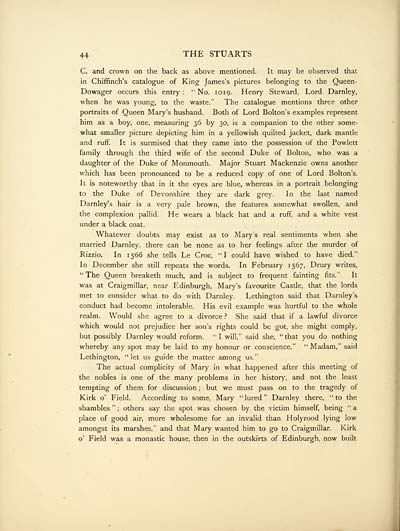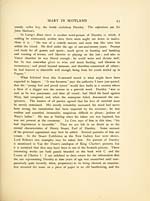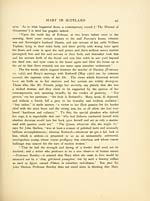Stuarts
(70) Page 44
Download files
Complete book:
Individual page:
Thumbnail gallery: Grid view | List view

44 THE STUARTS
C. and crown on the back as above mentioned. It may be observed that
in Chiffinch's catalogue of King James's pictures belonging to the Queen-
Dowager occurs this entry : " No. 1019. Henry Steward, Lord Darnley,
when he was young, to the waste." The catalogue mentions three other
portraits of Queen Mary's husband. Both of Lord Bolton's examples represent
him as a boy, one, measuring 36 by 30, is a companion to the other some-
what smaller picture depicting him in a yellowish quilted jacket, dark mantle
and ruff. It is surmised that they came into the possession of the Powlett
family through the third wife of the second Duke of Bolton, who was a
daughter of the Duke of Monmouth. Major Stuart Mackenzie owns another
which has been pronounced to be a reduced copy of one of Lord Bolton's.
It is noteworthy that in it the eyes are blue, whereas in a portrait belonging
to the Duke of Devonshire they are dark grey. In the last named
Darnley's hair is a very pale brown, the features somewhat swollen, and
the complexion pallid. He wears a black hat and a ruff, and a white vest
under a black coat.
Whatever doubts may exist as to Mary's real sentiments when she
married Darnley, there can be none as to her feelings after the murder of
Rizzio. In 1566 she tells Le Croc, "I could have wished to have died."
In December she still repeats the words. In February 1567, Drury writes,
"The Queen breaketh much, and is subject to frequent fainting fits." It
was at Craigmillar, near Edinburgh, Mary's favourite Castle, that the lords
met to consider what to do with Darnley. Lethington said that Darnley's
conduct had become intolerable. His evil example was hurtful to the whole
realm. Would she agree to a divorce ? She said that if a lawful divorce
which would not prejudice her son's rights could be got, she might comply,
but possibly Darnley would reform. "I will," said she, "that you do nothing
whereby any spot may be laid to my honour or conscience." " Madam," said
Lethington, "let us guide the matter among us."
The actual complicity of Mary in what happened after this meeting of
the nobles is one of the many problems in her history, and not the least
tempting of them for discussion ; but we must pass on to the tragedy of
Kirk o' Field. According to some, Mary "lured" Darnley there, "to the
shambles " ; others say the spot was chosen by the victim himself, being " a
place of good air, more wholesome for an invalid than Holyrood lying low
amongst its marshes," and that Mary wanted him to go to Craigmillar. Kirk
o' Field was a monastic house, then in the outskirts of Edinburgh, now built
C. and crown on the back as above mentioned. It may be observed that
in Chiffinch's catalogue of King James's pictures belonging to the Queen-
Dowager occurs this entry : " No. 1019. Henry Steward, Lord Darnley,
when he was young, to the waste." The catalogue mentions three other
portraits of Queen Mary's husband. Both of Lord Bolton's examples represent
him as a boy, one, measuring 36 by 30, is a companion to the other some-
what smaller picture depicting him in a yellowish quilted jacket, dark mantle
and ruff. It is surmised that they came into the possession of the Powlett
family through the third wife of the second Duke of Bolton, who was a
daughter of the Duke of Monmouth. Major Stuart Mackenzie owns another
which has been pronounced to be a reduced copy of one of Lord Bolton's.
It is noteworthy that in it the eyes are blue, whereas in a portrait belonging
to the Duke of Devonshire they are dark grey. In the last named
Darnley's hair is a very pale brown, the features somewhat swollen, and
the complexion pallid. He wears a black hat and a ruff, and a white vest
under a black coat.
Whatever doubts may exist as to Mary's real sentiments when she
married Darnley, there can be none as to her feelings after the murder of
Rizzio. In 1566 she tells Le Croc, "I could have wished to have died."
In December she still repeats the words. In February 1567, Drury writes,
"The Queen breaketh much, and is subject to frequent fainting fits." It
was at Craigmillar, near Edinburgh, Mary's favourite Castle, that the lords
met to consider what to do with Darnley. Lethington said that Darnley's
conduct had become intolerable. His evil example was hurtful to the whole
realm. Would she agree to a divorce ? She said that if a lawful divorce
which would not prejudice her son's rights could be got, she might comply,
but possibly Darnley would reform. "I will," said she, "that you do nothing
whereby any spot may be laid to my honour or conscience." " Madam," said
Lethington, "let us guide the matter among us."
The actual complicity of Mary in what happened after this meeting of
the nobles is one of the many problems in her history, and not the least
tempting of them for discussion ; but we must pass on to the tragedy of
Kirk o' Field. According to some, Mary "lured" Darnley there, "to the
shambles " ; others say the spot was chosen by the victim himself, being " a
place of good air, more wholesome for an invalid than Holyrood lying low
amongst its marshes," and that Mary wanted him to go to Craigmillar. Kirk
o' Field was a monastic house, then in the outskirts of Edinburgh, now built
Set display mode to:
![]() Universal Viewer |
Universal Viewer | ![]() Mirador |
Large image | Transcription
Mirador |
Large image | Transcription
Images and transcriptions on this page, including medium image downloads, may be used under the Creative Commons Attribution 4.0 International Licence unless otherwise stated. ![]()
| Histories of Scottish families > Stuarts > (70) Page 44 |
|---|
| Permanent URL | https://digital.nls.uk/95239891 |
|---|
| Description | A selection of almost 400 printed items relating to the history of Scottish families, mostly dating from the 19th and early 20th centuries. Includes memoirs, genealogies and clan histories, with a few produced by emigrant families. The earliest family history goes back to AD 916. |
|---|

